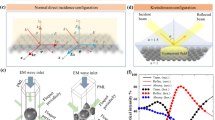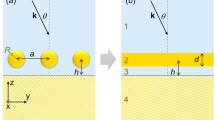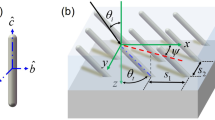Abstract
The reflection coefficients of a nanoparticle film are driven to a large extent by perpendicular and parallel interfacial susceptibilities that have the meaning of “dielectric thicknesses” which combine the actual geometry of the film and its dielectric properties. The direct determination of these parameters faces the long-standing issue of the derivation of complex optical constants from Fresnel coefficients via a unique spectroscopic measurement. The present work sets up an iterative algorithm based on inversion of the reflection coefficients recorded in the UV–visible range for two polarization states s and p and Kramers–Kronig (KK) analysis. To calculate the KK integrals over a limited energy window, the strategy was to complement measurements by spectra calculated in the framework of the spheroidal dipole approximation. The algorithm has been successfully tested on synthetic data of differential reflectivity for supported truncated spheres. These were chosen to span different dielectric behaviors, involving (a) for the particles, metals whose optical response is dominated by plasmonic excitations with a noticeable Drude behavior (Ag and Au) and (b) for the substrate, either nonabsorbing wide bandgap (alumina) or semiconducting (zincite and titania) oxides. Unlike the thin plate model, the approach was proven to apply to “dielectric thicknesses” of several tens of nanometres in cases in which, even for geometric sizes of the order of the nanometer, the classical long-wavelength dielectric approximation fails because of strong plasmon resonances. Therefore, the disentanglement of dielectric behaviors along the parallel and perpendicular directions simplifies the understanding on the interface polarization process by removing substrate contribution. The present work that deals with plasmonics in nanoparticles can be easily generalized to different morphologies as well as to other combinations of Fresnel coefficients.










Similar content being viewed by others
References
Stockman M (2011) Phys Today 64:39
Kreibig U, Vollmer M (1995) Optical properties of metal clusters, vol 25. Springer, Berlin
Bedeaux D, Vlieger J (2001) Optical properties of surfaces. Imperial College Press, London
Noguez C (2007) J Phys Chem 111:3806
McIntyre J, Aspnes D (1971) Surf Sci 24:417
Lazzari R, Jupille J (2012) Nanotechnology 23:135707
Grachev S, de Grazia M, Barthel E, Søndergård E, Lazzari R (2013) J Phys D Appl Phys 46:375305. 10pp
Oates T, Christalle E (2007) J Phys Chem C 111:182
Larsson E, Langhammer C, Zorić I, Kasemo B (2009) Science 326:1091
Gaudry M, Cottancin E, Pellarin M, Lermé J, Arnaud L, Huntzinger JR, Vialle JL, Broyer M, Rousset JL, Treilleux M, Mélinon P (2003) Phys Rev B 67:155409
Little SA, Begou T, Collins RW, Marsillac S (2012) Appl Phys Lett 100:051107
Drude P (1902) The theory of optics. Longmans, Green and Co, New York
Dignam M, Moskovits M, Stobie R (1971) Trans Faraday Soc 67:3306
Dignam M, Moskovits M (1973) J Chem Soc Faraday Trans II 69:56
Bagchi A, Barrera RG, Rajagopal AK (1979) Phys Rev B 20(12):4824
Feibelman PJ (1982) Prog Surf Sci 12:287
Hugerl K, Aspnes DE, Kamiya I, Florez LT (1993) Appl Phys Lett 63:885
Bedeaux D, Vlieger J (1973) Physica 67:55
Haarmans M, Bedeaux D (1995) Thin Solid Films 258:213
Proehl H, Nitsche R, Dienel T, Leo K, Fritz T (2005) Phys Rev B 71:165207
Pollak FH, Shen H (1993) Mat Sci and Eng 10:275
Hummel RE (1983) Phys Stat Sol 76:11
Borensztein Y, Abelès F (1985) Thin Solid Films 125:129
Lazzari R, Jupille J (2005) Phys Rev B 71:045409
Camacho-Flores J, Sun L, Saucedo-Zeni N, Weidlinger G, Hohage M, Zeppenfeld P (2008) Phys Rev B 78:075416
Lazzari R, Renaud G, Revenant C, Jupille J, Borenstzein Y (2009) Phys Rev B 79:125428
Debe MK (1987) Prog Surf Sci 24:1
Proehl H, Dienel T, Nitsche R, Fritz T (2004) Phys Rev Lett 93:097403
Simonsen I, Lazzari R, Jupille J, Roux S (2000) Phys Rev B 61(11):7722
Lazzari R, Simonsen I, Bedeaux D, Vlieger J, Jupille J (2001) Eur Phys J B 24:267
Lazzari R, Roux S, Simonsen I, Jupille J, Bedeaux D, Vlieger J (2002) Phys Rev B 65:235424
Lazzari R, Simonsen I, Jupille J (2003) Europhys Lett 61ll(4):541
Lazzari R, Jupille J (2011) Nanotechnology 22:445703
Beita C, Borensztein Y, Lazzari R, Nieto J, Barrera R (1999) Phys Rev B 60(8):6018
Román-Velázquez CE, Noguez C, Barrera RG (2000) Phys Rev B 61(15):10427
Lazzari R, Layet JM, Jupille J (2003) Phys Rev B 68:045428
Nitsche R, Fritz T (2004) Phys Rev B 70:195432
Henrichs S, Collier CP, Saykally RJ, Shen YR, Heath JR (2000) J Am Chem Soc 122:4077
Poelman D, Smet PF (2003) J Phys D Appl Phys 36:1850
Shiles E, Sasaki T, Inokuit M, Smith DY (1980) Phys Rev B 22:1612
Smith D (1985) Dispersion theory, sum rules and their applications in the analysis of optical data. In: Handbook of optical constants of solids, vol 1. Academic, New York, pp 35–64
Prange RE, Drew HD, Restorffg JB (1977) J Phys C Sol Stat Phys 10:5083
Moreels I, Allan G, De Geyter B, Wirtz L, Delerue C, Hens Z (2010) Phys Rev B 81:235319
Ahrenkiel R (1971) J Opt Soc Am 61:1651
Palmer K, William M, Budde B (1998) Appl Opt 37:2660
Kuzmenko A (2005) Rev Sci Inst 76:083108
Bohren CF, Huffman DR (1983) Absorption and scattering of light by small particles. Wiley, New York
Bobbert PA, Vlieger J (1987) Physica A 147:115
Wormeester H, Kooij S, Poelsema B (2003) Phys Rev B 68:085406
Wormeester H, Henry AI, Kooija ES, Poelsema B, Pileni MP (2006) J Chem Phys 124:204713
Albano AM, Bedeaux D, Vlieger J (1979) Physica A 99:293
Albano AM, Bedeaux D, Vlieger J (1980) Physica A 102:105
Bedeaux D, Vlieger J (1973) Physica A 73:287
Vlieger J, Bedeaux D (1980) Thin Solid Films 69:107
King F (1978) J Opt Soc. Am 68:994
Lazzari R, Simonsen I (2002) Thin Solid Films 419:124
Yamaguchi T, Yoshida S, Kinbara A (1973) Thin Solid Films 18:63
Yamaguchi T, Yoshida S, Kinbara A (1974) Thin Solid Films 21:173
Johnson P, Christy R (1972) Phys Rev B 6:4370
Campbell CT (1997) Surf Sci Rep 27(1–3):1
Wind MM, Vlieger J (1987) Physica A 141:33
Palik ED (1985) Handbook of optical constants of solids, vol. 1–3. Academic, New York
Jackson JD (1975) Classical electrodynamics. Wiley, New York
Haarmans MT, Bedeaux D (1993) Thin Solid Films 224:117
Acknowledgments
This work has been funded by Agence Nationale de la Recherche (ANR) (Program “Matériaux et Procédés pour des Produits Performants” contract ANR-2011-RMNP-010, COCOTRANS) and has benefited from a mobility grant AURORA between France and Norway.
Author information
Authors and Affiliations
Corresponding author
Appendix: Supported Spheroid Polarizability in the Spheroidal Dipole Approximation
Appendix: Supported Spheroid Polarizability in the Spheroidal Dipole Approximation
The aim of this appendix is to recall the expressions of the supported spheroid depolarization factors which are used as starting point of the inversion algorithm of SDRS. The geometry will be restricted to an oblate spheroid as it better describes the experimental particle flattening. Electrostatic interactions, both with the substrate and between particles, are kept at dipolar order for the sake of simplicity. Particles are ordered on a lattice of parameter L. Anyhow, equations for prolate case and up to the quadrupolar order can be easily found in the literature [3]. All the geometrical parameters are defined in the text and in Fig. 1.
The derivation of spheroid polarizabilities was obtained by Bobbert and Vlieger [3, 48, 56]; the Laplace equation is solved by using a multipolar spheroidal expansion [63] of the potential located both at the centers \(\mathcal {O}\) and at the image \(\mathcal {O}_{r}\) points in the substrate for all the spheroids. The continuity of the potential and of the normal derivative of the displacement field at the surface of the spheroids leads to an infinite set of linear equations for the spheroidal multipole coefficients. Once restricted to dipole interaction, the particle polarizability reads as follows:
where \(V=4/3 \pi a^{3} \xi_{0}(1+\xi_{0}^{2})\) is the spheroid volume. The depolarizations factors are given by
The dipole–dipole interaction between particles comes into play through the lattice sums (\(S_{20}\), \(S_{20}^{r}\)) over the direct \(\mathbf {R}_{i}\) and image \(\mathbf {R}_{i}^{r}\) points. They are defined through the following:
where \(Y_{2}^{0}(\theta ,\phi )\) is the spherical harmonics of order \(\ell =2,m=0\). They depend on the spherical angle from direct \((\theta ,\phi )\) or image \((\theta ^{r},\phi ^{r})\) points (Fig. 1). The sums are calculated using the convergence trick of ref. [64]. The IS in the spheroidal dipole approximation are related to the above polarizabilities through the following:
where \(\rho \) is the number of particles per surface unit.
Rights and permissions
About this article
Cite this article
Lazzari, R., Simonsen, I. & Jupille, J. Interfacial Susceptibilities in Nanoplasmonics via Inversion of Fresnel Coefficients. Plasmonics 9, 261–272 (2014). https://doi.org/10.1007/s11468-013-9619-6
Received:
Accepted:
Published:
Issue Date:
DOI: https://doi.org/10.1007/s11468-013-9619-6




